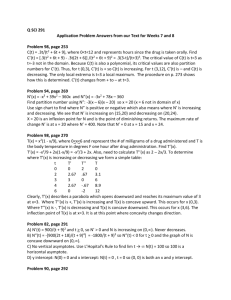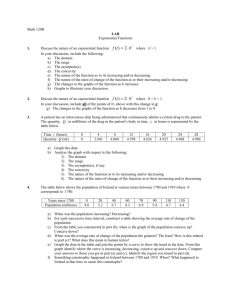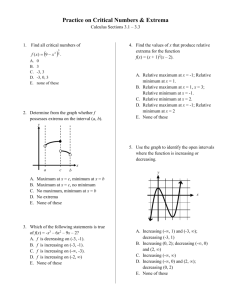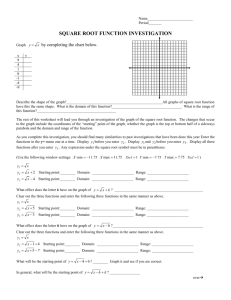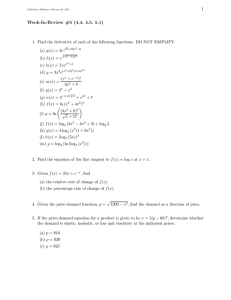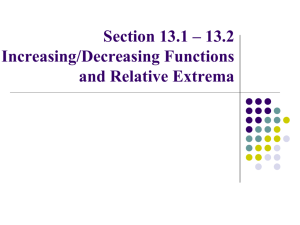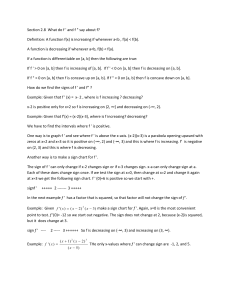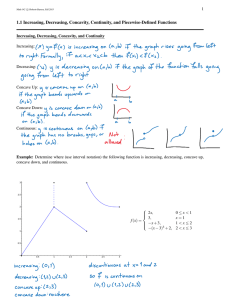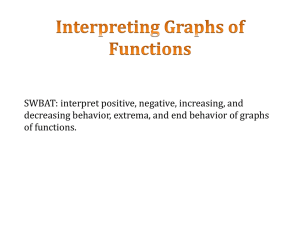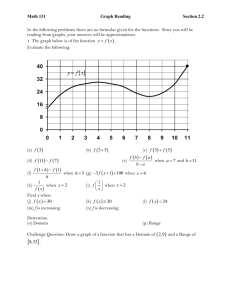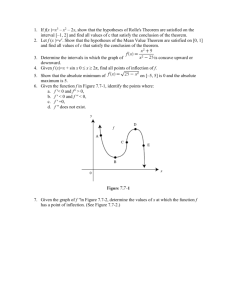Application Problem
advertisement
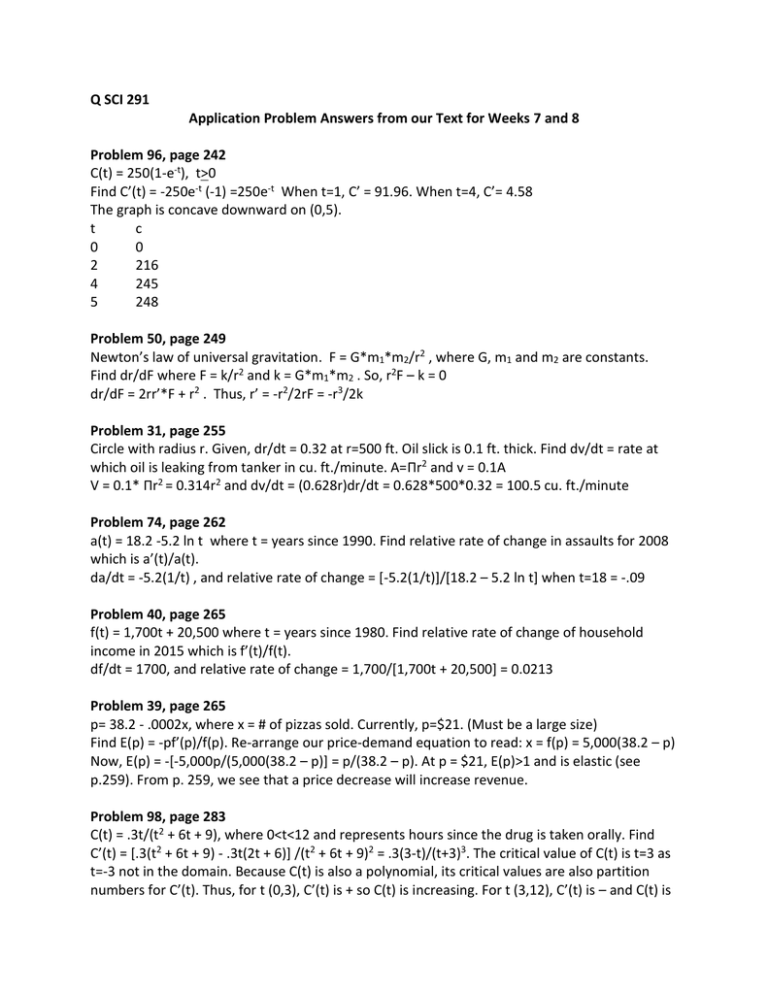
Q SCI 291 Application Problem Answers from our Text for Weeks 7 and 8 Problem 96, page 242 C(t) = 250(1-e-t), t>0 Find C’(t) = -250e-t (-1) =250e-t When t=1, C’ = 91.96. When t=4, C’= 4.58 The graph is concave downward on (0,5). t c 0 0 2 216 4 245 5 248 Problem 50, page 249 Newton’s law of universal gravitation. F = G*m1*m2/r2 , where G, m1 and m2 are constants. Find dr/dF where F = k/r2 and k = G*m1*m2 . So, r2F – k = 0 dr/dF = 2rr’*F + r2 . Thus, r’ = -r2/2rF = -r3/2k Problem 31, page 255 Circle with radius r. Given, dr/dt = 0.32 at r=500 ft. Oil slick is 0.1 ft. thick. Find dv/dt = rate at which oil is leaking from tanker in cu. ft./minute. A=Πr2 and v = 0.1A V = 0.1* Πr2 = 0.314r2 and dv/dt = (0.628r)dr/dt = 0.628*500*0.32 = 100.5 cu. ft./minute Problem 74, page 262 a(t) = 18.2 -5.2 ln t where t = years since 1990. Find relative rate of change in assaults for 2008 which is a’(t)/a(t). da/dt = -5.2(1/t) , and relative rate of change = [-5.2(1/t)]/[18.2 – 5.2 ln t] when t=18 = -.09 Problem 40, page 265 f(t) = 1,700t + 20,500 where t = years since 1980. Find relative rate of change of household income in 2015 which is f’(t)/f(t). df/dt = 1700, and relative rate of change = 1,700/[1,700t + 20,500] = 0.0213 Problem 39, page 265 p= 38.2 - .0002x, where x = # of pizzas sold. Currently, p=$21. (Must be a large size) Find E(p) = -pf’(p)/f(p). Re-arrange our price-demand equation to read: x = f(p) = 5,000(38.2 – p) Now, E(p) = -[-5,000p/(5,000(38.2 – p)] = p/(38.2 – p). At p = $21, E(p)>1 and is elastic (see p.259). From p. 259, we see that a price decrease will increase revenue. Problem 98, page 283 C(t) = .3t/(t2 + 6t + 9), where 0<t<12 and represents hours since the drug is taken orally. Find C’(t) = [.3(t2 + 6t + 9) - .3t(2t + 6)] /(t2 + 6t + 9)2 = .3(3-t)/(t+3)3. The critical value of C(t) is t=3 as t=-3 not in the domain. Because C(t) is also a polynomial, its critical values are also partition numbers for C’(t). Thus, for t (0,3), C’(t) is + so C(t) is increasing. For t (3,12), C’(t) is – and C(t) is decreasing. The only local extrema is t=3 a local maximum. The procedure on p. 273 shows how this is determined. C’(t) changes from + to – at t=3. Problem 92, page 299 N’(x) = -x3 + 39x2 – 360x and N”(x) = -3x2 + 78x – 360 Find partition number using N”: -3(x – 6)(x – 20) so x = 20 (x = 6 not in domain of x) Use sign chart to find where N” is positive or negative which also means where N’ is increasing and decreasing. We see that N’ is increasing on (15,20) and decreasing on (20,24). X = 20 is an inflexion point for N and is the point of diminishing returns. The maximum rate of change N’ is at x = 20 where N’ = 400. Note that N’ = 0 at x = 15 and x = 24. Problem 96, page 300 T(x) = x2(1 - x/9), where 0<x<6 and represent the # of milligrams of a drug administered and T is the body temperature in degrees F one hour after drug administration. Find T’(x). T’(x) = -x2/9 + 2x(1-x/9) = -x2/3 + 2x. Also, need to calculate T’’(x) as 2 – 2x/3. To determine where T’(x) is increasing or decreasing we form a simple table: t T’ T’’ T 0 0 2 0 2 2.67 .67 3.1 3 3 0 6 4 2.67 -.67 8.9 6 0 -2 12 Clearly, T’(x) describes a parabola which opens downward and reaches its maximum value of 3 at x=3. Where T’’(x) is +, T’(x) is increasing and T(x) is concave upward. This occurs for x (0,3). Where T’’(x) is -, T’(x) is decreasing and T(x) is concave downward. This occurs for x (3,6). The inflection point of T(x) is at x=3. It is at this point where concavity changes direction. Problem #42, Page 532 P(n)=1 + cos (Πn/26), where 0<n<104. Find P’(n). P’=-sin (Πn/26) (Π/26)= -Π/26 sin (Πn/26). The critical values occur when P’ = 0 which is when n=26, 52, or 78. Also calculate P’’ = -(Π/26)2 cos (nΠ/26). When we substitute values of n into P’’ we obtain: P’’(26) > 0; P’’(52) < 0; P’’(78) > 0. Thus, we can conclude that n=26 yields a local minimum; n=52 yields a local maximum; and n=78 yields a local minimum. To find the absolute maximum and minimum points we need to read Chapter 5-5. In essence we need to include the two end points where n=0 and n=104. P’’(0) and P’’(104) are < 0 implying that they are both absolute maximums and the three local extrema we found earlier can also be labeled as absolute maximum or minimums.

